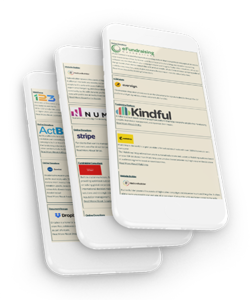Advanced Search allows you to create and run detailed and specific searches on various data points in your database. The results you receive via Advanced Search will be record-based. This means that when using this search method, you search for entities (Individuals and Organizations). If you are looking for specific transaction searches, Financial Reports will handle these needs.
There are two parts to Advanced Search: (1) searching for entities, and (2) using your search results.
(1) Searching for Entities
Advanced Search has four different modes for searching: Power Mode, Communication Filters, Contribution Filters, and Other Favorites. Contribution Filters and Other Favorites allow for quick and easy searching of common fields. Power Mode, however, is generally the mode to utilize as you begin your Advanced Search.
Power Mode
This function provides full system functionality and enables a search with robust criteria options. As with all four search modes, the Add Rule section is where you select the criteria that determine your results. In Power Mode, the following four fields appear under the Add Rule section header:
- Area: In the Select an area drop-down menu, choose from elements of an entity’s record, e.g., Addresses, Contributions, Flags, Key Stats.
- Field: In the Select a field drop-down menu, you will choose an option that is a subset of the chosen Area. For example, if you selected Addresses, you could select State.
- Relationship: In the Select a relationship drop-down menu, choose how to define the chosen Field further. For example, if you selected State and want only to find Addresses within a particular State, you would select Is Any of; in contrast, if you want to exclude Addresses from a specific State, you would select Is Not Any of.
- Value: Click in this box to access the drop-down menu. This is where you will either type the data point (e.g., the name of the State) or choose from a list of provided data points.
Once you have created your query, click the Add Rule button. This action will copy your selected criteria from the Add Rule section and paste it into the Search Criteria section. In many instances, this is the point at which you can click the Run Search button to complete your Advanced Search.
If your query is more complex, you may need to utilize one or more of the other three buttons.
The Add as Exclusion button will direct the system not to include any entities found with the criteria selected. After you click to add the rule, the buttons New Search Group and Add Compound Rule appear. These are advanced features that are used for more complex searches.
On the far left of the rule is an Edit button. Clicking this pulls the rule back into the Add Rule section to make changes. On the far right of the rule is a red X, which will remove the rule entirely from the Search Criteria section.
Clearing Your Search
If you need to clear all of your current search rules and start over, you can hit the blue Clear All button to the right of your search criteria.
Communications Filters
This mode allows you to search entities based solely on communication information.
You can select any Communication Type(s) within your chosen date range on this page.
Contribution Filters
This mode allows you to search entities based solely on contribution information.
When using this mode, you can determine how the system searches for contribution information within a record. These are Total Contributions, Most Recent Contribution, and Any Contribution. You can also narrow down search results based on Date Range, Amount Range, and Election.
When you’ve chosen or entered all the criteria, you’ll again have the buttons described above to add the rule to the Search Criteria section.
Other Favorites
This mode is used for other Address and Flag-related results.
This mode allows you to select from various Address and Flag-related data points. For example, you can determine your results based on City, County, ZIP Code, and State. Use the Flags field to locate entities that have specific flags.
When you’ve chosen or entered all the criteria, you’ll again have the buttons described above to add the rule to the Search Criteria section.
(2) Using Your Search Results
You have several options for using your results, including displaying, exporting, and bulk updating the data. Most options are found on the Exports & Actions menu:
- Run Search: Generates the search results directly on the screen.
- Excel: Custom Export: Select any Custom Export spreadsheet formats you’ve created.
- Call Sheets: Generates PDF pages of the results and will include basic contribution and contact information.
- Copy To Another Account: If you manage multiple accounts, this will copy the entities, including their contact information, and add them to the account of your choice.
- Excel: Basic Contact Information: Provides a spreadsheet with entity contact information only.
- Excel Donor Summary: Provides donor-specific information.
- Excel Detailed Fundraising Export: Provides most of the donor information and additional fundraising details.
- Excel: Detailed Fundraising Export by Household: This is the same as above, but it will group records linked with the spouse relationship.
- Set Communications: Apply a communication to the records found in your results.
- Set Flags: Select a flag to apply to all the records in your results.
- Set Followup Reminders: Create a reminder to contact the entity on a later or specific date.
- Set Pledges/Targets: Create and set a Pledge or Target for the results of your search.
- Start Drip Campaign: Begin an email Drip Campaign with the entities in your search results, as well as allow AI to update the campaign for you.
- View Records: Opens the record’s details page, starting with the first result. You will have an option at the bottom left and right of the entity records to flip through the records displayed.
- Save & Run Search: Provides the ability to save the search criteria in case it is a report you will run frequently, as well as generate the results directly on the screen.
Other Actions
Saved Searches is where you will find all of the searches that you have saved. This is also where you can manage them by removing or updating the name of a saved search.
Custom Exports allows you to update and create Custom Exports you would like to use to export only the details you want.
On the Scheduled Reports page, you are able to select your Saved Advanced Searches as a Report option. Note that this will only be a Scheduled Report option if you have a Custom Export already built.
Advanced Search Recipes
Here are step-by-step instructions on how to generate some of the more common searches:
- How Do I Exclude Results Based on Flags?
- All Non-Donors
- Transactions by Creation Date
- Donors Over the Limit
- State and Local Districts
- General Election Non-Donors
Related Information
- How Do I Filter My Advanced Search by State and Local Districts?
- How Do I Create and Manage Custom Exports?
- What Are the New Search Group and Add Compound Rule Buttons in Advanced Search?
- What Are Advanced Search Recipes?
- How Do I Find All PACs That Gave in the Primary and General Cycle?
- How Do I Find Donors Who Gave to the Primary but Not the General?
- How Do I Locate Donors Over the Limit?
- How Do I Find Transactions Added on a Specific Date?
- How Do I Locate First Time Donors Using Advanced Search?
- How Do I Exclude Results Based on Flags Using Advanced Search?
- How Do I Isolate Out-Of-State Income Using Advanced Search?
- How Do I Find Non-donors?
- How Do I Find Communications Made By Date and/or Type?
- How Do I Locate Foreign Addresses Using Advanced Search?
- How Do I Set Flags Using Advanced Search & AI?
- How Do I Copy Data Between My Accounts?
- What Is the Difference Between Actor and User Fields in Advanced Search?
- How Do I Locate Uncontacted Individuals Using Advanced Search?






